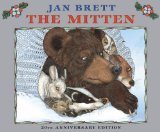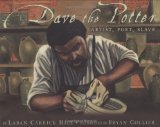Dawn Little's Blog, page 15
February 6, 2012
The Mitten by Jan Brett
Recommended Grades: K-2
When Nicki drops his mitten in the snow and continues to play without realizing it. One by one, woodland animals find the mitten and crawl in.
Lesson Idea:
Making Predictions: Written in her unique style, Jan Brett provides a book that not only tells a story through text, but also through the pictures. Read aloud The Mitten and point out the pictures to students. Ask students to use the pictures to make predictions about what they think will happen as you read.
©2012 by Dawn Little for Picture This! Teaching with Picture Books. All Amazon links are affiliate links and may result in my receiving a small commission. This is at no additional cost to you.
Filed under: comprehension strategies, Making Predictions, The Mitten Tagged: Making Predictions, reading comprehension strategies, The Mitten by Jan Brett








January 30, 2012
Ducky by Eve Bunting
Recommended Grades: 4-6
A crate of bathtub toys are washed overboard in a storm. As waves crash all around them, the animals are separated until Ducky is left all alone. Will he wash ashore and find a friend?
Lesson Idea:
Six Traits:
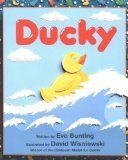

Idea Development: This picture book is based on a true event that took place in 1992. What a fantastic way to develop a story. Read aloud Ducky and ask students to peruse newspaper articles for idea seeds. You can also read aloud 10 Little Rubber Ducks
and ask students to peruse newspaper articles for idea seeds. You can also read aloud 10 Little Rubber Ducks by Eric Carle (based on the same incident) and compare how two authors began with the same idea, but developed two different stories.
by Eric Carle (based on the same incident) and compare how two authors began with the same idea, but developed two different stories.
Organization: "I am a yellow plastic duck and I am in great danger." This sentence begins the story of Ducky and hooks the reader. Provide Ducky
and hooks the reader. Provide Ducky as a mentor text when modeling hooks.
as a mentor text when modeling hooks.
©2012 by Dawn Little for Picture This! Teaching with Picture Books. All Amazon links are affiliate links and may result in my receiving a small commission. This is at no additional cost to you.
Filed under: Ducky by Eve Bunting, ideas, organization, six traits of writing Tagged: Ducky by Eve Bunting, idea development, six traits of writing, Teaching organization








January 23, 2012
Library Lil by Suzane Williams
Recommended Grades: 3-5
An original tall tale about Lil who was born with a book in her hand.
Lesson Idea:
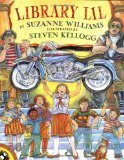

Writers Workshop: As part of a unit on tall tales, read aloud Library Lil and discuss the elements of exaggeration that exist. After examining the elements of exaggeration through multiple mentor texts, ask students to write a tall tale about themselves.
and discuss the elements of exaggeration that exist. After examining the elements of exaggeration through multiple mentor texts, ask students to write a tall tale about themselves.
©2012 by Dawn Little for Picture This! Teaching with Picture Books. All Amazon links are affiliate links and may result in my receiving a small commission. This is at no additional cost to you.
Filed under: Library Lil by Suzanne Williams, motivation, tall tales, teaching with picture books, writers workshop Tagged: Library Lil by Suzanne Williams, tall tales, writers workshop








January 16, 2012
Snow Day! by Lester L. Laminack
Recommended Grades: 3-5
When the weatherman predicts an overnight snowfall, the narrator dreams of all the fun he can have on his day off from school. Children will enjoy the surprise ending.
Lesson Idea:
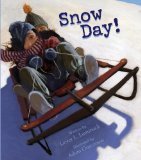

Six Traits: Organization: Read aloud Snow Day! Discuss the surprise ending. Pair it with other books with surprise endings (First Day Jitters, I Want My Hat Back) as mentor texts. Have students use the models to guide their own writing by encouraging students to write a piece with a surprise ending.
Discuss the surprise ending. Pair it with other books with surprise endings (First Day Jitters, I Want My Hat Back) as mentor texts. Have students use the models to guide their own writing by encouraging students to write a piece with a surprise ending.
©2012 by Dawn Little for Picture This! Teaching with Picture Books. All Amazon links are affiliate links and may result in my receiving a small commission. This is at no additional cost to you.
Filed under: organization, six traits of writing, Snow Day by Lester Laminack, surprise endings, teaching with picture books Tagged: organization, six traits of writing, Snow Day by Lester Laminack, surprise endings








January 9, 2012
How to Teach a Slug to Read by Susan Pearson
Recommended Grades: K-2
A cute story of a slug who gives his top ten tips on how to teach a slug to read. The tips mirror actual strategies that adults should use when teaching children to read.
Lesson Idea:
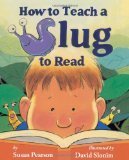

Motivating Readers: Read aloud How to Teach a Slug to Read and discuss how the strategies are similar to strategies teachers or parents use with children. Create a class list of strategies good readers use to post andrefer to as students are learning how to read.
and discuss how the strategies are similar to strategies teachers or parents use with children. Create a class list of strategies good readers use to post andrefer to as students are learning how to read.
©2012 by Dawn Little for Picture This! Teaching with Picture Books. All Amazon links are affiliate links and may result in my receiving a small commission. This is at no additional cost to you.
Filed under: How to Teach a Slug to Read, motivation, teaching with picture books Tagged: How to Teach a Slug to Read, motivating readers








January 2, 2012
Blackout by John Rocco
Recommended Grades: 4-6
It was a normal summer night in the city. . . hot, noisy, busy. Then the lights went out. The story of one family and what they do when the lights go out.
Lesson Idea:
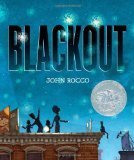

Making Inferences: Read aloud Blackout and model for students how the pictures tell as much of the story as the text does (maybe more). Model how to make inferences using the pictures as clues (Why might the lights have gone out? Why does the family continue to keep the lights out even when they are back on?)
and model for students how the pictures tell as much of the story as the text does (maybe more). Model how to make inferences using the pictures as clues (Why might the lights have gone out? Why does the family continue to keep the lights out even when they are back on?)
©2012 by Dawn Little for Picture This! Teaching with Picture Books. All Amazon links are affiliate links and may result in my receiving a small commission. This is at no additional cost to you.
Filed under: Blackout, comprehension strategies, making inferences Tagged: Blackout by John Rocco, comprehension strategies, making inferences








December 26, 2011
Sit -In: How Four Friends Stood Up By Sitting Down by Andrea Davis Pinkney
Recommended Grades: 4-6
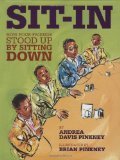

It was February 1, 1960. They didn't need menus. Their order was simple. A doughnut and coffee, with cream on the side. The story of the sit-in at Woolworth's during the WHITES ONLY edict of the era is poignantly told through this picture book.
Note: This month, I will share several Black Eyed Susan nominees. Sit-In: How Four Friends Stood Up by Sitting Down (Jane Addams Honor Book (Awards)) is a 2011-2012 nominee.
is a 2011-2012 nominee.
Lesson Idea:
History Connection: I love to read picture books with historical significance. This is one such story. Read aloud Sit-In: How Four Friends Stood Up by Sitting Down (Jane Addams Honor Book (Awards)) and discuss the historical significance during a unit on civil rights. Pairing Sit-In: How Four Friends Stood Up by Sitting Down (Jane Addams Honor Book (Awards))
and discuss the historical significance during a unit on civil rights. Pairing Sit-In: How Four Friends Stood Up by Sitting Down (Jane Addams Honor Book (Awards)) with If A Bus Could Talk: The Story of Rosa Parks
with If A Bus Could Talk: The Story of Rosa Parks by Faith Ringgold or Rosa (Caldecott Honor Book)
by Faith Ringgold or Rosa (Caldecott Honor Book) by Nikki Giovanni would make a great picture book unit on civil rights and perhaps make the concept easier for students to understand.
by Nikki Giovanni would make a great picture book unit on civil rights and perhaps make the concept easier for students to understand.
Writer's Workshop: Use Sit-In: How Four Friends Stood Up by Sitting Down (Jane Addams Honor Book (Awards)) as a mentor text for history based picture books. Provide other models of history based picture books. Then have students pick a specific historical event and write their own picture book.
as a mentor text for history based picture books. Provide other models of history based picture books. Then have students pick a specific historical event and write their own picture book.
©2011 by Dawn Little for Picture This! Teaching with Picture Books. All Amazon links are affiliate links and may result in my receiving a small commission. This is at no additional cost to you.
Filed under: civil rights, Content Connections, teaching with picture books, writers workshop Tagged: civil rights, content connections, mentor texts, Sit-In: How Four Friends Stood Up by Sitting Down, writers workshop








December 19, 2011
The Lion's Share: A Tale of Halving Cake and Eating It, Too by Matthew McElligott
Recommended Grades: 4-6
When the ant is invited to dinner with the King of the Jungle, she is mortified when the other party goers gobble up dessert (halving each piece for each party goer) leaving nothing but a crumb for the ant to share with the lion. As a result, she offers to bake him a special dessert for the next night. A lesson in manners and math, this book makes a great read aloud.
Note: This month, I will share several Black Eyed Susan nominees. The Lion's Share: A Tale of Halving Cake and Eating It, Too is a 2011-2012 nominee.
is a 2011-2012 nominee.
Lesson Idea:
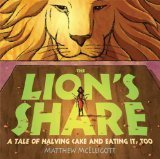

Math Connection: Read aloud The Lion's Share: A Tale of Halving Cake and Eating It, Too at the beginning of a math unit on multiplication and division. Provide students with manipulatives and have them re-create the scenario when the animals halve the cake and then again when the animals double the cake.
at the beginning of a math unit on multiplication and division. Provide students with manipulatives and have them re-create the scenario when the animals halve the cake and then again when the animals double the cake.
©2011 by Dawn Little for Picture This! Teaching with Picture Books. All Amazon links are affiliate links and may result in my receiving a small commission. This is at no additional cost to you.
Filed under: Math, teaching with picture books, The Lion's Share Tagged: math connections, multiplication and division, The Lion's Share: A Tale of Halving Cake and Eating It, Too








December 12, 2011
A Pig Parade is a Terrible Idea by Michael Ian Black
Recommended Grades: 4-6
Like most children, you probably think a pig parade is a terrific idea. . . this book begins, but the author shows you exactly why a pig parade is a terrible idea.
Note: This month, I will share several Black Eyed Susan nominees. A Pig Parade is a Terrible Idea  is a 2011-2012 nominee.
is a 2011-2012 nominee.
Lesson Idea:


Model Texts: I've written about model texts before, and this one is a great example of a model text to teach persuasive writing to students. Read aloud A Pig Parade is a Terrible Idea  and discuss the techniques the author uses to persuade the reader that the idea of a pig parade is a bad one. The author also utilizes great sequencing words and a surprise wrap up that's worth investigating. Perhaps, use the ending as a starter for students to write their own persuasive piece.
and discuss the techniques the author uses to persuade the reader that the idea of a pig parade is a bad one. The author also utilizes great sequencing words and a surprise wrap up that's worth investigating. Perhaps, use the ending as a starter for students to write their own persuasive piece.
©2011 by Dawn Little for Picture This! Teaching with Picture Books. All Amazon links are affiliate links and may result in my receiving a small commission. This is at no additional cost to you.
Filed under: Persuasive writing, teaching with picture books, writers workshop Tagged: A Pig Parade is a Terrible Idea, model texts, persuasive writing, writers workshop








December 5, 2011
Dave the Potter: Artist, Poet, Slave by Laban Carrick Hill
Recommended Grades: 4-6
Dave was an important American artist. Dave was a potter and a slave, who was gifted in the way of words. Not only did Dave create pottery, he added a poem to each one.
Note: This month, I will share several Black Eyed Susan nominees. The Black-Eyed Susan Committee of the Maryland Association of School Librarians nominates books each fall. Dave the Potter: Artist, Poet, Slave is a 2011-2012 nominee.
is a 2011-2012 nominee.
Trait: Word Choice: After reading aloud Dave the Potter: Artist, Poet, Slave , discuss the author's use of words to describe the life of Dave. In the author's note in the back, Hill describes how he began his own poem about Dave to create this intriguing picture book. How does the author use poetry to describe Dave's life? How does he use descriptive words? Encourage students to work with words to create a writing piece that is descriptive and perhaps, poetic.
, discuss the author's use of words to describe the life of Dave. In the author's note in the back, Hill describes how he began his own poem about Dave to create this intriguing picture book. How does the author use poetry to describe Dave's life? How does he use descriptive words? Encourage students to work with words to create a writing piece that is descriptive and perhaps, poetic.
©2011 by Dawn Little for Picture This! Teaching with Picture Books. All Amazon links are affiliate links and may result in my receiving a small commission. This is at no additional cost to you.
Filed under: Content Connections, Dave the Potter: Artist Poet Slave, six traits of writing, word choice Tagged: Dave the Potter by Laban Carrick Hill, six traits of writing, word choice









